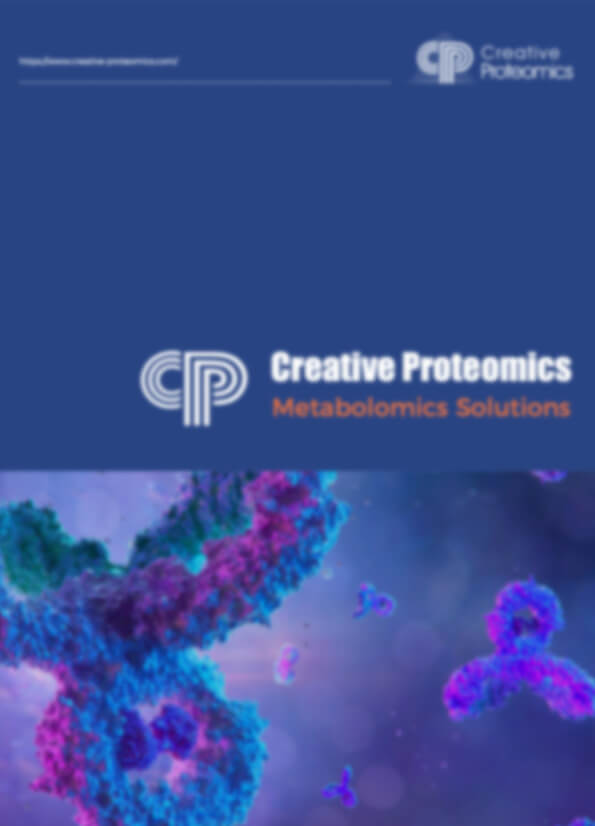Mevalonic Acid Analysis Service
Creative Proteomics excels in mevalonic acid analysis, providing accurate quantification and comprehensive metabolic profiling with state-of-the-art LC-MS/MS and GC-MS platforms. We support drug development, metabolic research, and biotechnology applications by detecting MVA and its intermediates with exceptional sensitivity (<0.1 ng/mL) and efficient throughput (1,000+ samples/month), delivering reliable data for informed decision-making.
Submit Your Request Now
×- What We Provide
- Advantages
- Technology Platform
- Sample Requirements
- FAQ
- Publications
What is Mevalonic Acid?
Mevalonic acid (MVA) is a critical intermediate in the mevalonate pathway, a metabolic route essential for synthesizing sterols (e.g., cholesterol), isoprenoids (e.g., coenzyme Q10), and other bioactive molecules. This pathway begins with acetyl-CoA and proceeds through 3-hydroxy-3-methylglutaryl-CoA (HMG-CoA), which is converted to MVA by HMG-CoA reductase—a key enzyme targeted by statins for cholesterol regulation. Disruptions in MVA metabolism are linked to cardiovascular diseases, neurodegenerative disorders, and cancer, making its quantification vital for biomedical and industrial research.
Mevalonic Acid Analysis Service Offered by Creative Proteomics
- Mevalonic Acid Absolute Quantification: Accurate measurement of MVA and its intermediates using isotope-labeled internal standards and LC-MS/MS technology.
- Metabolic Pathway Profiling and Flux Analysis: Comprehensive detection and quantification of MVA pathway metabolites, with metabolic flux analysis to trace carbon flow and assess enzymatic activity.
- Customized Panels: Targeted analysis of specific metabolites, such as IPP and DMAPP, or expanded panels covering sterols and isoprenoids.
- Multi-Omics Integration: Combining MVA data with proteomics or transcriptomics for a systems-level view of metabolic regulation.
- Comparative Metabolomics: Evaluating metabolic changes across different conditions for biomarker discovery and drug development.
Detectable Mevalonic Acid-Related Metabolites
| Metabolite Name | Abbreviation | Biological Role |
|---|---|---|
| Mevalonic Acid | MVA | Key precursor for isoprenoid biosynthesis |
| Mevalonate-5-Phosphate | MVA-P | Intermediate in cholesterol biosynthesis |
| Mevalonate-5-Pyrophosphate | MVAPP | Essential for sterol and non-sterol isoprenoid synthesis |
| Isopentenyl Pyrophosphate | IPP | Fundamental isoprene unit in the biosynthesis of terpenoids |
| Dimethylallyl Pyrophosphate | DMAPP | Isomer of IPP, used in isoprenoid synthesis |
| Geranyl Pyrophosphate | GPP | Precursor for monoterpenes and other terpenoids |
| Farnesyl Pyrophosphate | FPP | Key intermediate in cholesterol and steroid biosynthesis |
| Geranylgeranyl Pyrophosphate | GGPP | Involved in protein prenylation and isoprenoid biosynthesis |
| Squalene | - | Precursor for cholesterol synthesis |
| Lanosterol | - | Initial sterol in the cholesterol biosynthesis pathway |
| Cholesterol | - | End-product of the mevalonate pathway |
| Dolichol | - | Involved in protein glycosylation |
| Ubiquinone (Coenzyme Q) | CoQ | Essential in the electron transport chain |
| HMG-CoA (3-Hydroxy-3-Methylglutaryl-CoA) | HMG-CoA | Precursor for MVA in the mevalonate pathway |
| HMG-CoA Reductase Product | - | Product of HMG-CoA reductase catalysis |
| Farnesol | - | Involved in protein modification and signaling |
| Geranylgeraniol | - | Precursor in the biosynthesis of dolichols and CoQ |
| Isoprenoids | - | Diverse class of biomolecules derived from IPP and DMAPP |
Advantages of Mevalonic Acid Assay
- Comprehensive Detection: Dual-platform analysis using LC-MS/MS and GC-MS ensures broad metabolite coverage and accurate quantification.
- High Sensitivity and Accuracy: Detection limits as low as 0.1 ng/mL with inter-batch variability under 5% using isotope-labeled internal standards.
- Metabolic Flux Analysis: Real-time tracking of carbon flow to assess enzymatic activity and pathway regulation.
- Fast Turnaround and High Throughput: Process up to 1,000 samples/month with results in 10-20 business days.
- Robust Data Analysis: Advanced interpretation using MS/MS spectral libraries and KEGG-based pathway mapping for actionable insights.
- Flexible Sample Handling: Supports diverse sample types with adaptive protocols for low-volume or degraded samples.
Technology Platforms for Mevalonic Acid Analysis Service
HPLC-UV (High-Performance Liquid Chromatography with UV Detection)

Agilent 1260 Infinity II HPLC (Figure from Agilent)
GC-MS (Gas Chromatography-Mass Spectrometry)

Agilent 7890B-5977B (Figure from Agilent)
LC-MS/MS (Liquid Chromatography-Tandem Mass Spectrometry)

SCIEX Triple Quad™ 6500+ (Figure from Sciex)
Sample Requirements for Mevalonic Acid Analysis Service
| Sample Type | Minimum Volume/Amount Required | Recommended Volume/Amount | Storage Conditions | Notes |
|---|---|---|---|---|
| Plasma | 100 µL | 200 µL | -80°C | Collect in EDTA or heparin tubes, centrifuge, and separate plasma immediately. |
| Serum | 100 µL | 200 µL | -80°C | Allow blood to clot for 30 minutes before centrifugation. |
| Urine | 500 µL | 1 mL | -20°C or -80°C | First-morning urine preferred for metabolic profiling. |
| Tissue Homogenates | 50 mg | 100 mg | -80°C | Snap freeze in liquid nitrogen and store at -80°C. Homogenize in extraction buffer if needed. |
| Cultured Cells | 1 × 10⁶ cells | 5 × 10⁶ cells | -80°C | Wash cells twice with cold PBS and pellet before freezing. |
| Cell Culture Media | 500 µL | 1 mL | -80°C | Collect media without serum or phenol red for metabolite analysis. |
| CSF (Cerebrospinal Fluid) | 100 µL | 200 µL | -80°C | Store in sterile, labeled tubes. Avoid hemolysis. |
| Saliva | 200 µL | 500 µL | -80°C | Rinse mouth with water 30 minutes prior to collection. |
| Feces | 50 mg | 100 mg | -80°C | Collect in sterile tubes and freeze immediately. |
| Plant or Microbial Extracts | 50 mg or 500 µL | 100 mg or 1 mL | -80°C | Provide information on extraction method if applicable. |
Applications of Mevalonic Acid Assay Service
Metabolic Pathway Research
Understand the regulation and function of the mevalonate pathway in lipid biosynthesis.
Drug Development
Assess the impact of drug candidates on cholesterol biosynthesis and lipid metabolism.
Biotechnology
Optimize microbial production of isoprenoids, biofuels, and pharmaceuticals through metabolic pathway monitoring.
Agricultural Research
Study lipid metabolism in plants to enhance crop yield, quality, and stress resistance.
Nutritional Science
Investigate how dietary components affect lipid biosynthesis and metabolic health.
Basic Research
Explore enzyme activity, gene function, and metabolic flux for deeper insights into cellular metabolism.
Demo
FAQ of Mevalonic Acid Analysis Service
What is the sensitivity of your MVA quantification?
Our LC-MS/MS platform achieves a lower limit of quantification (LLOQ) of 0.5 ng/mL for MVA in plasma/serum, validated per ICH guidelines.
Do you support analysis of non-human samples (e.g., plants, microbes)?
Yes. We accept plant tissues, microbial cultures, and animal models (e.g., rat plasma), with optimized extraction protocols for each matrix.
How do you handle matrix interference in complex samples?
We use solid-phase extraction (SPE) and isotope dilution (e.g., ²H₄-MVA) to suppress matrix effects, ensuring >85% recovery
Can you analyze both MVA and its lactone form?
Absolutely. Our methods distinguish mevalonic acid and mevalonic acid lactone with >95% chromatographic resolution.
What is the maximum sample throughput?
Our automated workflow processes 200+ samples/week (e.g., serum, urine), ideal for large-scale clinical or industrial studies.
Do you validate pathway flux dynamics?
Yes. We integrate 13C-labeled tracers and metabolic flux analysis (MFA) to quantify carbon flow from acetyl-CoA to IPP/DMAPP.
Learn about other Q&A.
Mevalonic Acid Analysis Service Case Study
Publications
Here are some of the metabolomics-related papers published by our clients:

- A non-probiotic fermented soy product reduces total and ldl cholesterol: A randomized controlled crossover trial. 2021. https://doi.org/10.3390/nu13020535
- Resting natural killer cell homeostasis relies on tryptophan/NAD+ metabolism and HIF‐1α. 2023. https://doi.org/10.15252/embr.202256156
- Enhance trial: effects of NAD3® on hallmarks of aging and clinical endpoints of health in middle aged adults: a subset analysis focused on blood cell NAD+ concentrations and lipid metabolism. 2022. https://doi.org/10.3390/physiologia2010002
- Function and regulation of a steroidogenic CYP450 enzyme in the mitochondrion of Toxoplasma gondii. 2023. https://doi.org/10.1371/journal.ppat.1011566
References
- Cao, Yujin, et al. "Metabolic engineering of Escherichia coli for the utilization of ethanol." Journal of Biological Research-Thessaloniki 27 (2020): 1-10. https://doi.org/10.1186/s40709-020-0111-0
- Saini, G. S., et al. "Validation of the LC-MS/MS method for the quantification of mevalonic acid in human plasma and determination of the matrix effect." Journal of lipid research 47.10 (2006): 2340-2345. https://doi.org/10.1194/jlr.D600018-JLR200









